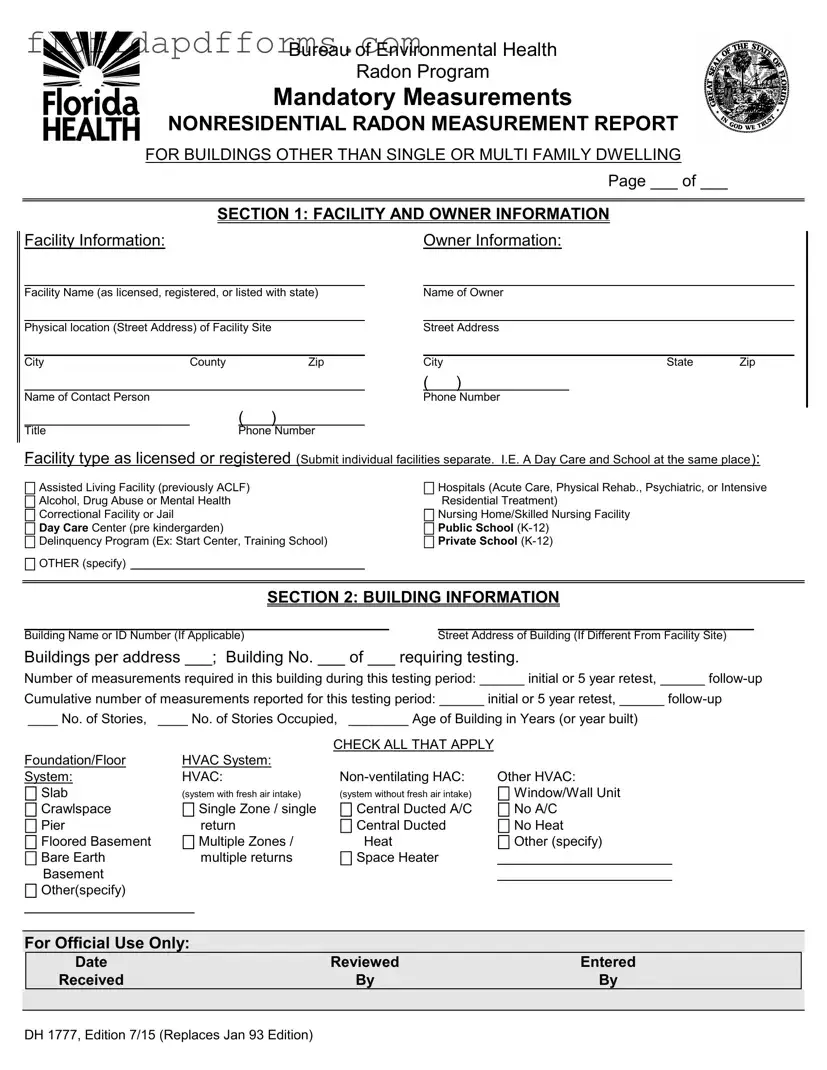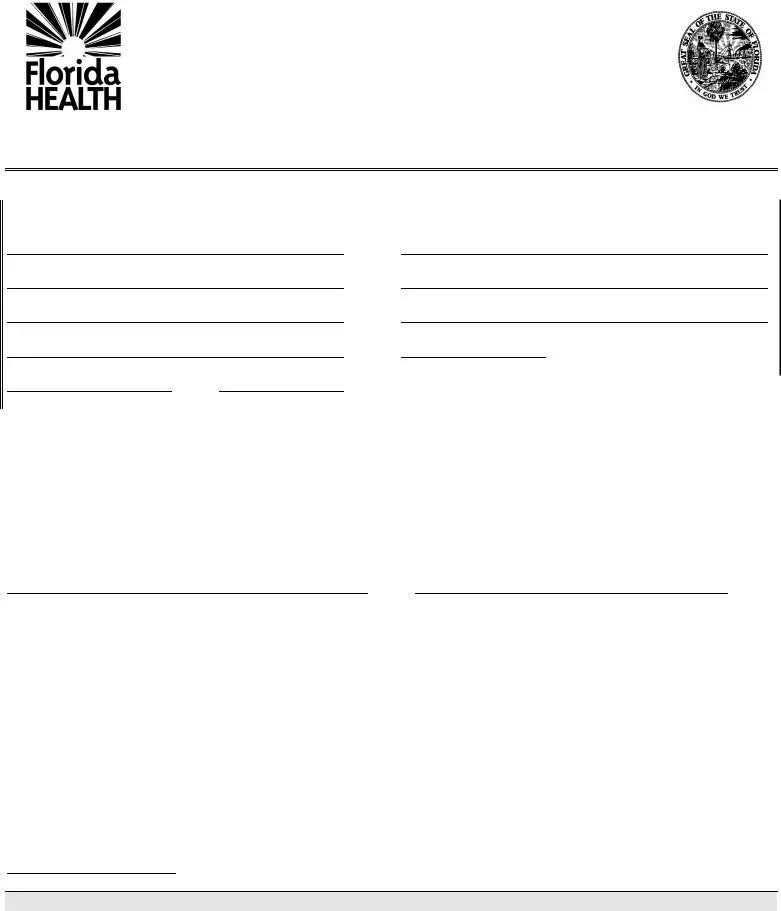Bureau of Environmental Health
Radon Program
Mandatory Measurements
NONRESIDENTIAL RADON MEASUREMENT REPORT
FOR BUILDINGS OTHER THAN SINGLE OR MULTI FAMILY DWELLING
Page ___ of ___
SECTION 1: FACILITY AND OWNER INFORMATION
Facility Information: |
Owner Information: |
Facility Name (as licensed, registered, or listed with state)
Physical location (Street Address) of Facility Site
Name of Contact Person
Name of Owner
Street Address
()
Phone Number
()
TitlePhone Number
Facility type as licensed or registered (Submit individual facilities separate. I.E. A Day Care and School at the same place):
Assisted Living Facility (previously ACLF) |
Hospitals (Acute Care, Physical Rehab., Psychiatric, or Intensive |
Alcohol, Drug Abuse or Mental Health |
Residential Treatment) |
Correctional Facility or Jail |
Nursing Home/Skilled Nursing Facility |
Day Care Center (pre kindergarden) |
Public School (K-12) |
Delinquency Program (Ex: Start Center, Training School) |
Private School (K-12) |
OTHER (specify) |
|
|
|
|
|
|
|
|
|
|
SECTION 2: BUILDING INFORMATION
Building Name or ID Number (If Applicable)Street Address of Building (If Different From Facility Site)
Buildings per address ___; Building No. ___ of ___ requiring testing.
Number of measurements required in this building during this testing period: ______ initial or 5 year retest, ______ follow-up
Cumulative number of measurements reported for this testing period: ______ initial or 5 year retest, ______ follow-up
____ No. of Stories, ____ No. of Stories Occupied, ________ Age of Building in Years (or year built)
Foundation/Floor
System:
Slab
Crawlspace
Pier
Floored Basement
Bare Earth Basement
Other(specify)
|
CHECK ALL THAT APPLY |
|
HVAC System: |
|
|
HVAC: |
Non-ventilating HAC: |
Other HVAC: |
(system with fresh air intake) |
(system without fresh air intake) |
Window/Wall Unit |
Single Zone / single |
Central Ducted A/C |
No A/C |
return |
Central Ducted |
No Heat |
Multiple Zones / |
Heat |
Other (specify) |
multiple returns |
Space Heater |
|
|
|
|
|
For Official Use Only:
|
Date |
Reviewed |
Entered |
|
|
Received |
By |
By |
|
|
|
|
|
|
DH 1777, Edition 7/15 (Replaces Jan 93 Edition)
|
|
|
|
|
|
|
SECTION 3: RESULTS |
|
|
|
|
Measurement Type: Initial or 5 Year Retest, Follow-up |
|
|
|
|
Dates of Measurement: FROM |
/ / |
|
TO |
/ / |
|
|
|
|
|
|
|
|
|
|
|
|
|
|
|
|
|
|
|
Name of Person who performed Measurement (Placed Device) |
|
† |
|
|
Certificate No. (If Applicable) |
|
|
|
|
|
|
|
|
|
|
|
|
‡ |
|
Story |
|
Room |
Result |
|
Units |
|
Device |
|
|
Time in Hours |
|
|
|
|
|
|
|
|
|
|
|
|
|
|
|
|
|
|
|
|
|
|
|
|
|
|
|
|
|
|
|
|
|
|
|
|
|
|
|
|
|
|
|
|
|
|
|
|
|
|
|
|
|
|
|
|
|
|
|
|
|
|
|
|
|
|
|
|
|
|
|
|
|
|
|
|
|
|
|
|
|
|
|
|
|
|
|
|
|
|
|
|
|
|
|
|
|
|
|
|
|
|
|
|
|
|
|
|
|
|
|
|
|
|
|
|
|
|
|
|
|
|
|
|
|
|
|
|
|
|
|
|
|
|
|
|
|
|
|
|
|
|
|
|
|
|
|
|
|
|
|
|
|
|
|
|
|
|
|
|
|
|
|
|
|
|
|
|
|
|
† P for pCi/L or W for WL
‡ AC-Activated Carbon Adsorption, AT-Alpha Track, CR-Continuous Radon Monitor, CW-Continuous Working Level Monitor, EL-Electret Ion Chamber Long Term, ES-Electret Ion Chamber Short Term, LS- Liquid Scintillation, RP-RPISU, UT-Unfiltered Alpha Track
SECTION 4
COMPLETE ONLY IF MEASUREMENTS ARE PERFORMED BY A RADON MEASUREMENT BUSINESS
Name of Business and Cert. No. |
Name of Specialist and Cert. No. |
Signature of Specialist
SECTION 5
COMPLETE ONLY IF MEASUREMENTS ARE PERFORMED BY STAFF EMPLOYED BY THE FACILITY
I hereby certify that the Radon measurements reported herein have been performed in accordance with Chapter 64E-5, Florida Administrative Code, and Chapter 404, Florida Statutes.
Authorized Representative of Facility |
|
Date |
Upon completion of this form, send to:
Department of Health
Bureau of Environmental Health / Radon Program
4052 Bald Cypress Way, Bin #A12
Tallahassee, FL 32399-1720
You may scan the report and email it to RadonReports@FLhealth.gov
For Assistance in Completing this Form call 1-800-543-8279


